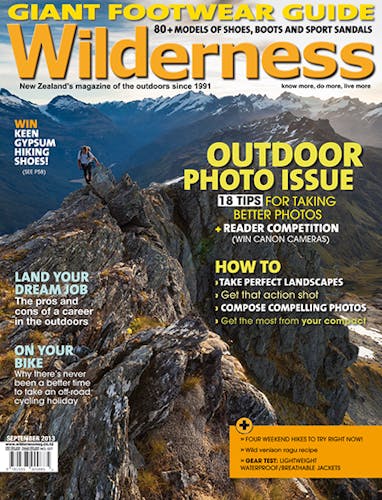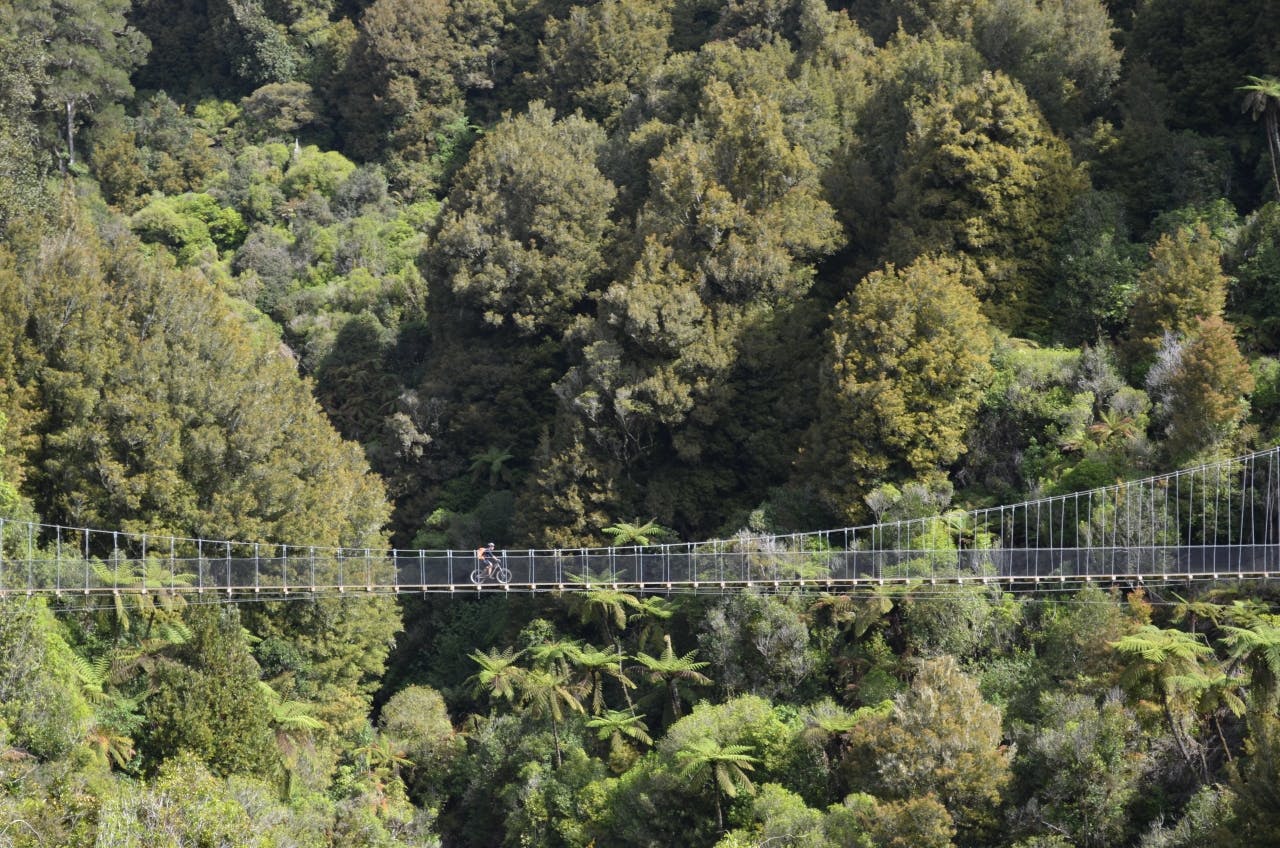There has never been a better time to take an off-road cycling holiday in New Zealand
Cycling in New Zealand has hit boom time.
Cyclists are so spoiled for choice when it comes to cycle trails says the man who knows all of our off-road trails inside out, that the face of cycling in New Zealand has changed forever.
Avid cyclist and guide book author Jonathan Kennet says a $50 million investment by the government to create new cycle trails around the country, has transformed cycle holidays in this country.
Known as Nga Haerenga, or the New Zealand Cycle Trail, the government millions have directly contributed to 19 new cycle trails built in the north and south islands in the past five years.
“It’s absolutely transformed New Zealand cycling holidays,” Kennett says. “In the past, someone thinking of going on a cycling holiday didn’t have a lot of options for a multi-day trip. That’s not the case anymore.
“All of a sudden, the number of options has boomed. It’s created a lot of interest in cycling, especially at the easier end of the spectrum.”
The demand for off-road cycle trails and cycling holidays is a global trend, Kennett says.
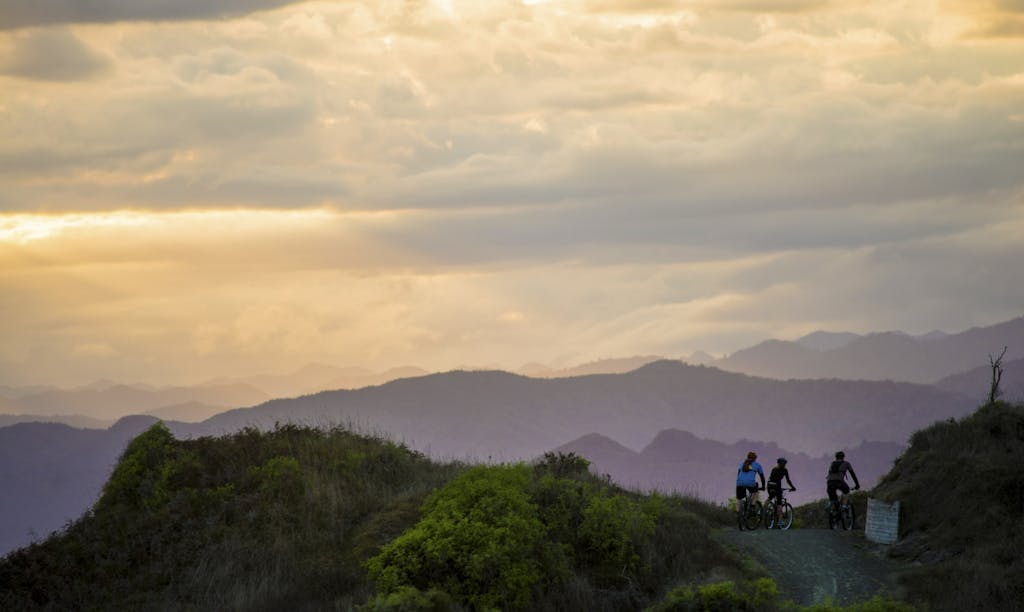
Cyclists enjoy a late evening ride through the dunes on the Motu Trails, on the North Island’s east coast Photo: MOTU TRAILS CHARITABLE TRUST
While we’re not world leaders when it comes to catering for cyclists, Kennett believes we have outstripped our Australian neighbours and it’s attracting more Australians to cross the ditch. After Kiwis, Australian tourists are the second biggest group of riders on our trails, says Kennett, who is also a project manager for Nga Haerenga.
The cycle trail project was born in 2009 when Prime Minister John Key’s jobs summit spawned the idea of building a cycle trail the length of the country.
Heady ideas of a continuous trail from Cape Reinga to Bluff were soon abandoned, but the government pledged $50 million to create a series of ‘great rides’ around the country, in the hope it would bring jobs, stimulate regional economies and enhance New Zealand’s competitiveness as a tourism destination.
The grand plan is for 21great rides, of which 13 are now fully open – including the Otago Central Rail Trail and the Queen Charlotte Track which have since come under the New Zealand Cycle Trail banner. The remainder are partially open, with most expected to be completed by the end of the year. Only one has yet to begin construction, however tenders for Southland’s Around the Mountains Trail have been called for and work is expected to begin soon.
For off-road cyclists, this means a bonanza of 2000km of trails to choose from.
Project manager John Dunn says 600km of existing trails were incorporated into the Nga Haerenga network, but the $50 million investment, plus a further $30 million of community fundraising has seen 1000km of new off-road trails constructed, with another 400km still to come.
“I have been lucky enough to ride all of them and I get pretty excited every time I jump on one of them,” Dunn says.
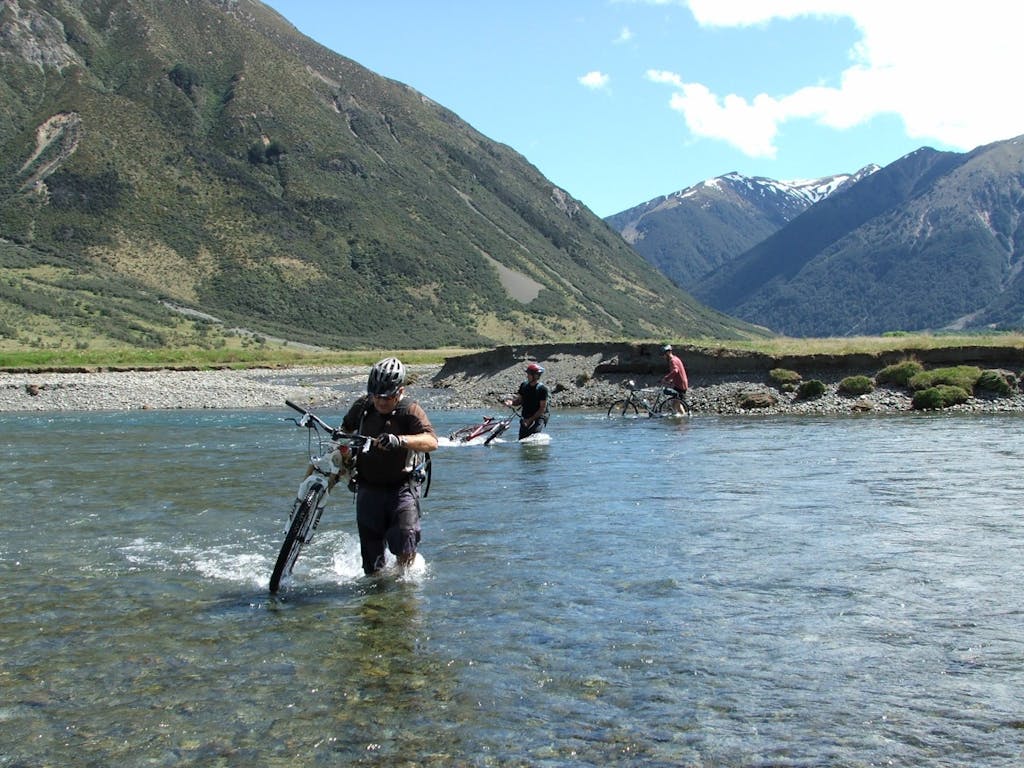
A new bridge means cyclists no longer need to get wet feet to cross the Waiau River on the St James Trail Photo: John Dunn
The depth of interest in cycle trails around the country was well demonstrated when applications for funding were first called for. A huge pile of Christmas reading landed on Dunn’s desk, when 54 applications for funding came in. “We were surprised to get so much interest,” he says.
Dunn says not one application “went in the bin” and the team “liked every single one of them”. Each application was ranked according to set criteria, such as the level of community involvement and whether the trail incorporated iconic natural, historic or cultural landscapes.
Land access is one of the biggest barriers to creating new trails, but no money was spent buying land, Dunn says. All land access had to be negotiated.
The team then basically began allocating money down the list and “ruled a line” when they had spent their quota.
The initial $50m paid for 19 new trails, which is great for cyclists, but what has this investment delivered in terms of its original founding intent – to create jobs?
According to Dunn, more than 1000 construction jobs will have been on offer by the time the project is finished. And now the long term employment opportunities of tourism jobs are starting to build.
“An interesting aspect of cycle trails is that they provide a really good opportunity for someone to go into an enterprise by themselves, or with one or two other people,” Dunn says.
For example, a person doesn’t need to build a massive hotel to provide accommodation, but can set up a simple bed and breakfast as a small business.
Dunn cites the Otago Central Rail Trail as the inspiration for how a cycle trail can transform local communities. First opened in 2000, about 120 people are now employed to specifically cater for the needs of cyclists who come to ride the trail.
“We’re not saying you can multiply that number by 20 trails, but it’s an aspirational number to get to.”
Otago Central Rail Trail trustee Daphne Hull, who has been involved with the trail since its inception and chaired the trust for 10 years, says the economic benefits the rail trail has brought are huge.
“Before the rail trail was put in, those little communities were dying,” she says. Every town had a shop, a pub and a school, but they were all gradually closing. Today those same towns are revitalised. New buildings are going up as businesses to service the rail trail develop. And it’s not just locals, Hull says. People from Auckland and Australia are also arriving to set up businesses.
From such economic impacts, social benefits also flow, as people once again take pride in their community. “Even now, I’m thrilled and amazed when I drive through those towns and see the huge difference,” says Hull.
From an estimated 5000 people using the rail trail when the full length first opened, 14,000 people now ride the entire length of the trail each year, and it’s estimated at least another 14,000 are riding parts of the trail. Hull believes these are conservative estimates. “When we first started we never imagined it would be like this,” she says.
Other new trails around the country are already experiencing higher than expected visitor numbers. Queenstown Trails Trust chief executive Kaye Parker says when the almost 100km Queenstown Trail was officially opened last year, the expectation of 25,000 to 30,000 visitors within five years seemed a bit optimistic.
When their counters recorded 90,000 visitors in the first six months, they were blown away.
“It is beyond our wildest expectations. Cycling has just exploded,” she says.
And businesses in the region agree, Parker says. The owner of a newly built café at the Frankton marina says on wet or cold days her turnover drops by a third, without the cyclists on the trail stopping for their first coffee. The Kawarau Bridge Bungy has grown, with noticeable numbers of Lycra-clad people on the viewing decks and sipping coffee in the café. Businesses in the small township of Arrowtown say they also have noticeably benefited from cyclists using the trail.
Parker says a less monetary benefit of the trail has been to provide a “wonderful, off-road commute to schools and for workers”.
Last month the Queenstown Trails Trust bought the well-established Motatapu off-road sporting event from Iconic Adventures. The profits from running this event will help the trust facilitate and fund trails throughout the Wakatipu Basin. They have plans to extend the Queenstown Trail and make parts of it wheelchair accessible.
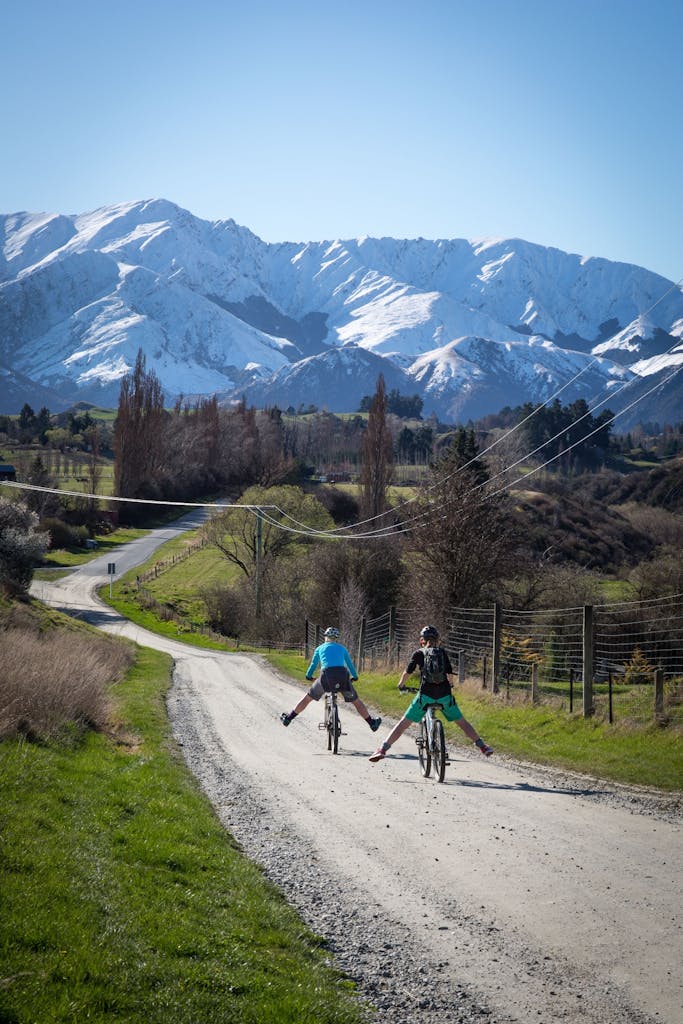
Having fun on the Queenstown Trail in Otago Photo: Jim Pollard
The track is “beautifully crafted” and a big feature of the trail is “the new, hidden vistas around every corner”, Parker says. “It is easy in parts and then is a good intermediate trail in others.”
In the central North Island, the 85km Timber Trail, which runs through the Pureora Forest Park, isn’t anywhere near the same league in visitor numbers, but Department of Conservation Maniapoto area manager Ray Scrimgeour believes the recently-opened trail could bring many benefits to the surrounding quiet, farming communities.
As this part of the King Country is not close to the big urban centres, Scrimgeour doesn’t anticipate the “tens of thousands” visiting the likes of the Hauraki Rail Trail, but predictions of up to 4000 visitors a year could be a real boon to the area.
“I think this will make quite a difference to the small rural communities nearby; places that have been stagnating for decades and are close to extinction,” he says. “The few local businesses tell me they are doing very well out of increased visitation.”
At the moment there are no services, such as accommodation or cafés, on the trail, with the closest amenities generally at least half an hour away. The department, in a slightly unusual move, has gone to the market to call for expressions of interest to develop tourism infrastructure on conservation land along the trail.
Pureora Forest Park has traditionally been the domain of hunters, but Scrimgeour expects there will be a huge shift in the visitor profile. Queens Birthday weekend is not traditionally a busy time in the park, but this year “the car parks were chocka”, he says.
The easy to intermediate trail doesn’t have the expansive views or alpine scenery of the South Island trails, but for the chance to experience back country New Zealand bush by bike, it is unparalleled, says Scrimgeour.
Kennet also rates the Timber Trail as one of his North Island favourites. It has a lot of fascinating history and goes through incredible forest, he says. “It is just beautiful, original podocarp forest.”
Looking to the future, Dunn says it is now time to consolidate and build the tourism infrastructure around each trail, so there are no barriers for people to get on their bikes and on the track.
The government is in the process of setting up a new governance body to lead the future development of the New Zealand Cycle Trail. This body will be made up of local representatives from trails around the country.
There are no indications of further government funding, but it is possible more trails could join the great rides network, such as the Christchurch-Little River Rail Trail and the proposed Wellington-Wairarapa Cycle Trail.
So called ‘touring routes’ are also being developed, which will utilise quieter back roads to connect the great rides. Kennett says for those that like cycle touring it is “completely feasible” to cycle the length of the country.
For more information about each of the trails visit www.nzcycletrail.com or pick up a copy of Classic New Zealand Cycle Trails, by the Kennett brothers.
With so many trails to choose from where do you start?
Cycling guide book author and New Zealand Cycle Trail project manager Jonathan Kennett says the key is to be selective and choose what suits you. Factors taken into account when grading the difficulty of a trail include the steepness and length of the climbs, and the technicality of the track, such as how rough it is and the number of obstacles.
“Some people love having cafés and accommodation, whereas other people want to get away from it all and basically go tramping on wheels,” he says.
People who find rail trails “a bit lame” can head to trails like the Old Ghost Road, Queen Charlotte Track and the St James Cycle Trail for a much more wilderness experience, Kennett says.
On your bike in the North Island
Great Lake Trail, Central North Island
Distance 93km. Still under construction, but two sections between Whakaipo Bay and Whangamata Rd are open
Grade Intermediate
Highlights Follows the western shore of Lake Taupo.
Hauraki Rail Trail, Waikato
Distance 69km, off-road
Grade Easy
Highlights The Karangahake Gorge, an historic gold mining town and luxurious mineral spas.
Hawke’s Bay Trails, Hawke’s Bay
Distance 187km – sections open, mostly off-road
Grade Easy to intermediate
Highlights Three distinct experiences taking in the landscapes, sea and wetland views, and the region’s wineries.
Motu Trails, East Coast
Distance 132km, two off-road trails and one on-road trail
Grade Easy to advanced
Highlights Offers a range of possibilities for all abilities and fitness, including a challenging loop ride from Opotiki.
Mountains to Sea, Whanganui/Manawatu
Distance 317km, a mix of on and off-road trails
Grade Intermediate to advanced
Highlights Traversing two national parks from the mountains of the Central Plateau to the sea at Whanganui.
The Timber Trail, Central North Island
Distance 77km, off-road
Grade Easy to intermediate
Highlights Passing through podocarp forest, this trail features 35 bridges, including eight suspension bridges.
Thermal by Bike
Distance 74km, a mix of on and off-road
Grade Intermediate
Highlights From Rotorua to Orakei Korako this trail takes riders through four geothermal fields.
Twin Coast Cycle Trail, Northland
Distance 84km. Sections open with construction expected to be completed by the end of 2013. A mix of on and off-road trails
Grade Easy to intermediate
Highlights Traversing from coast to coast in the far north, a unique feature of this trail is a series of Pou along the route, which were hand-carved by local iwi.
Waikato River Trails, Waikato
Distance 100km, off-road
Grade Easy to advanced
Highlights Following the Waikato River, towering dams, suspension bridges and long meandering boardwalks.
[sub head] On your bike in the South Island
Alps 2 Ocean Cycle Trail, Canterbury/Otago
Distance 310km, a mix of on and off-road
Grade Intermediate
Highlights Starts in Mt Cook Village and finishes at Oamaru, taking in Lake Pukaki and the Waitaki Valley.
Around the Mountains, Southland
Distance 175km. Construction yet to begin
Grade Intermediate
Clutha Gold Trail, Otago
Distance 75km, mostly off-road
Grade Easy
Highlights Trail follows the Clutha River and has a strong historical element. It also links with the Roxburgh Gorge Trail and the Otago Central Rail Trail.
Dun Mountain Trail, Nelson/Tasman
Distance 38km, off-road
Grade Intermediate to advanced
Highlights A one day ride from Nelson, rising to 1129m to give great views.
Great Taste Trail, Nelson/Tasman
Distance Between 38km and 175km, a mix of on and off-road trails
Grade Easy to intermediate
Highlights Starting and finishing in Nelson, this circular route takes in coastal and inland scenery.
Otago Central Rail Trail, Otago
Distance 150km, off-road
Grade Easy
Highlights Cyclists are well catered for on this trail, with a wide range of accommodation and services.
Queen Charlotte Track, Marlborough
Distance 70km, off-road
Grade Intermediate to advanced
Highlights Ride through coastal forest and along skyline ridges with the advantage of easy road access and boat transport to ride short sections if necessary.
Roxburgh Gorge Trail, Otago
Distance 34km – presently closed with the last 4km expected to be finished this month, all off-road
Grade Intermediate
Highlights Following the Clutha Mata-Au river, bluffs rise to 350m on either side of the river at the most dramatic point.
St James Cycle Trail, Canterbury
Distance 64km, all off-road
Grade Easy to advanced
Highlights One of the first great rides to open, there is a chance of seeing the St James wild horses on this high country ride.
The Old Ghost Road, West Coast
Distance 80km – either end is open, with the middle section expected to be completed by the end of next year, all off-road
Grade Advanced
Highlights From open river valleys to the alpine tops, with purpose-built huts, this trail offers a true cycling wilderness experience.
The Queenstown Trail, Otago
Distance 99km, off-road
Grade Easy to intermediate
Highlights A big feature of this trail is hidden vistas around every corner. Cyclists are well catered for along the trail.
West Coast Wilderness Trail, West Coast
Distance 120km. Presently closed with 30km to be constructed, mostly off-road
Grade Easy to intermediate





